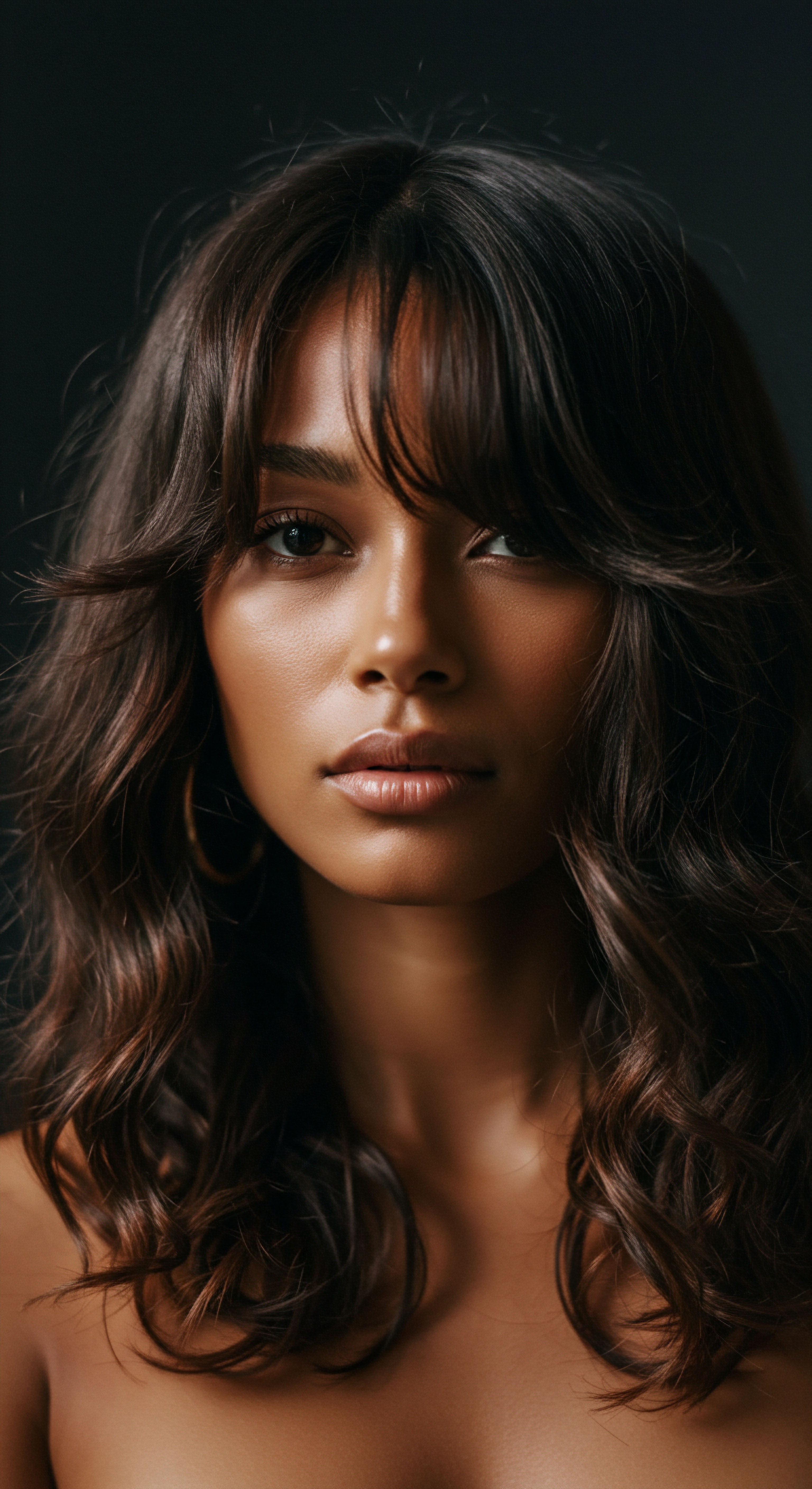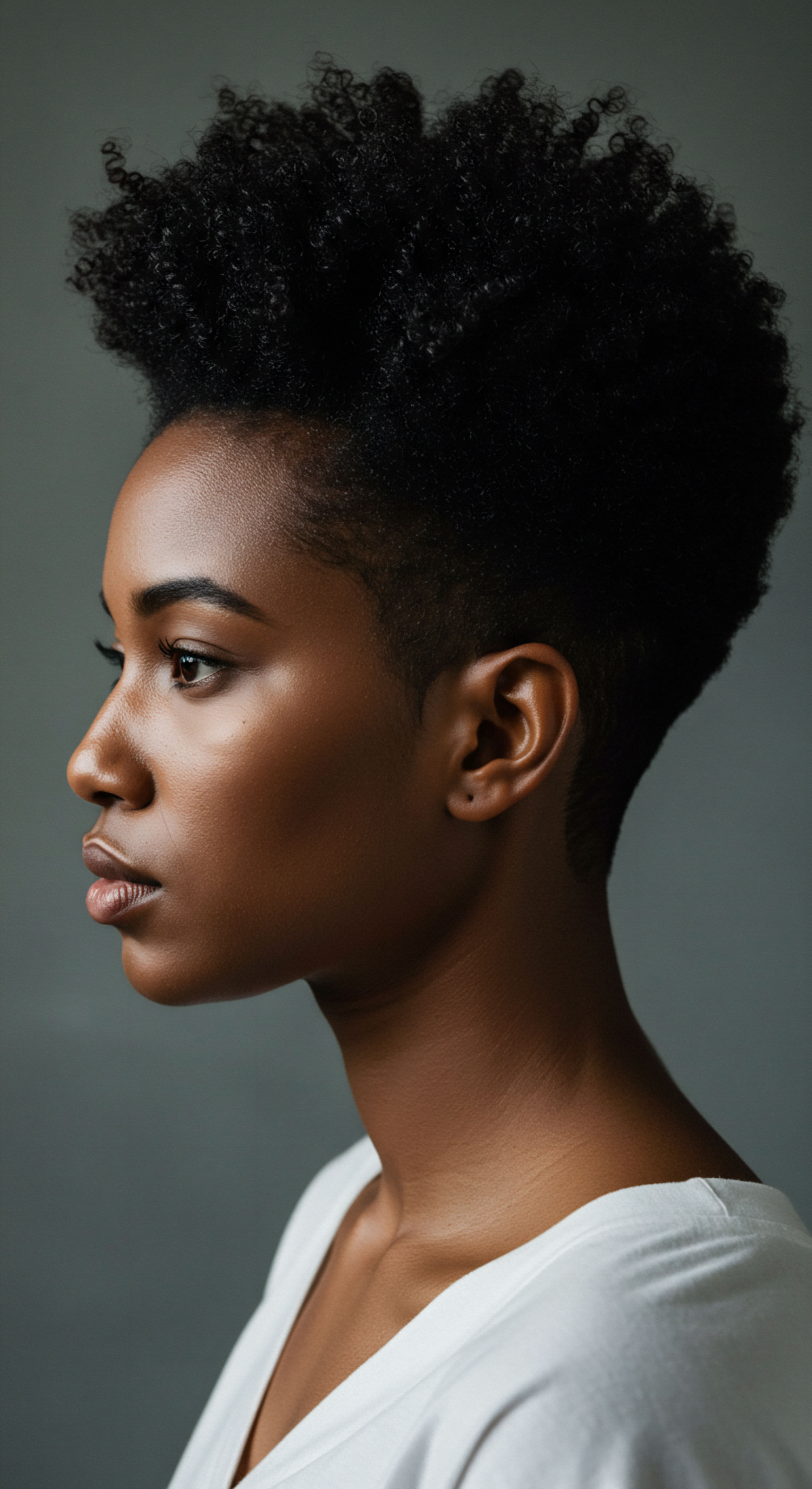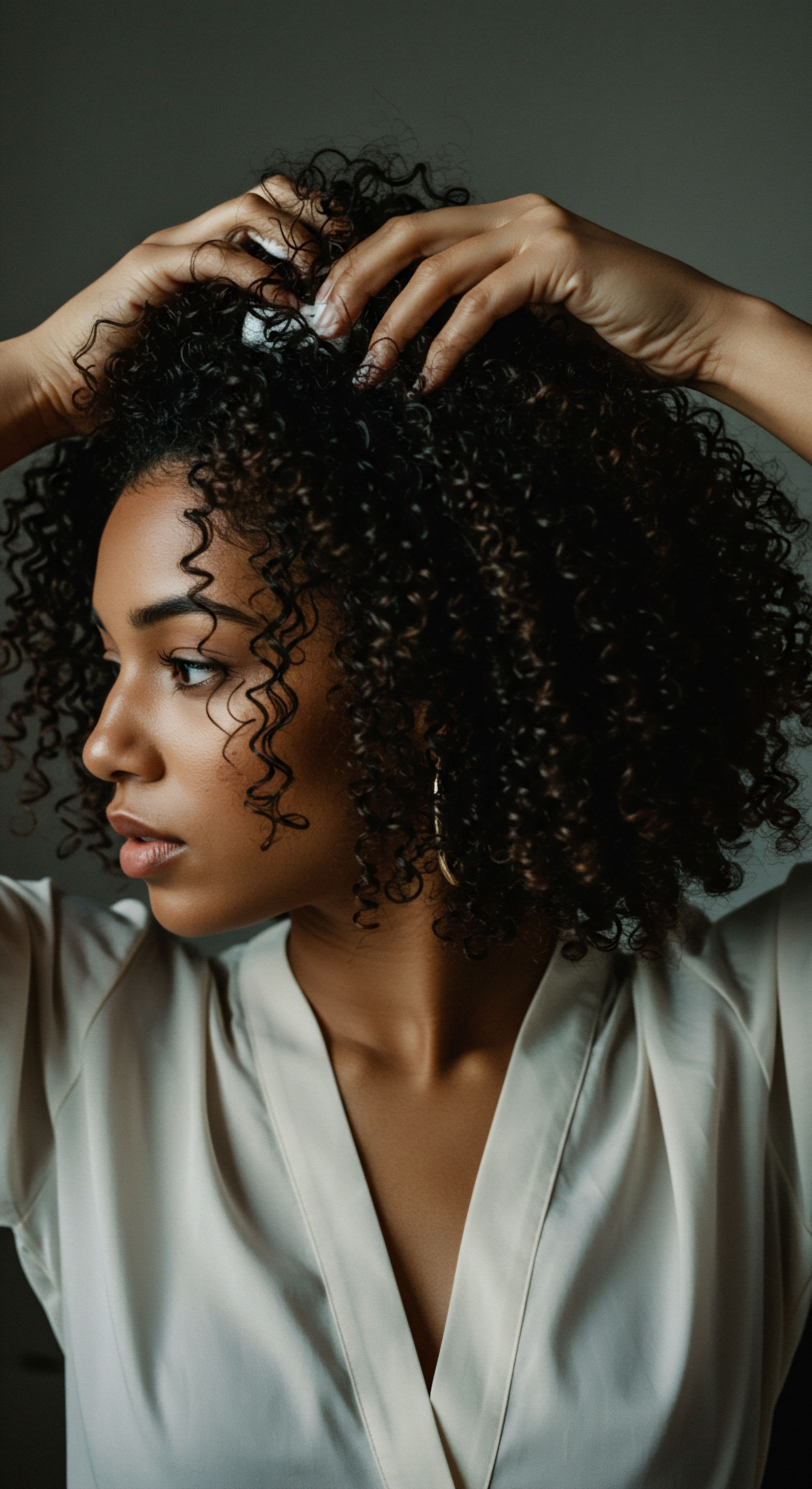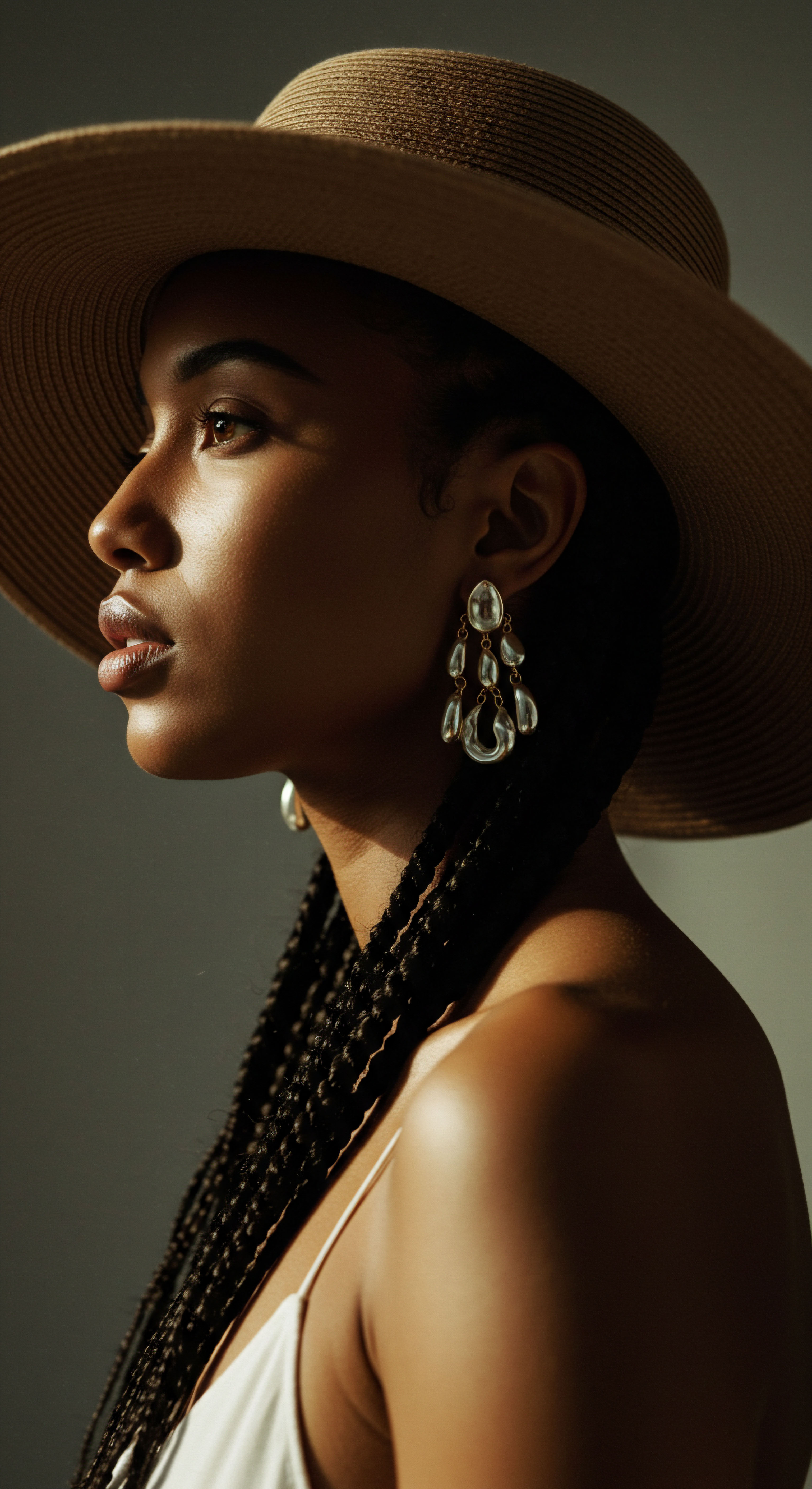The journey of hair, particularly for those with textured, Black, and mixed hair, extends far beyond mere aesthetics; it embodies a profound narrative of identity, resilience, and cultural continuity. Roothea understands that hair is a living testament to heritage, a delicate yet potent connection to ancestral wisdom and personal truth. The very strands that crown our heads hold stories of triumph and adaptation, demanding a respect that acknowledges their intricate biology, historical significance, and the profound personal meaning they carry. This reverence, this understanding of Heritage Hair Respect, moves beyond superficial care to embrace a holistic appreciation for the unique characteristics of every coil, curl, and wave.

Fundamentals
At its simplest expression, Heritage Hair Respect denotes an acknowledgment of the inherent value and distinctive characteristics of textured hair, particularly Black and mixed hair types. It signals a departure from universalized beauty norms, instead advocating for practices and perceptions that honor the natural state of these hair textures. This foundational understanding is crucial for anyone beginning their exploration into the world of authentic textured hair care, laying the groundwork for deeper engagement.
The concept of Heritage Hair Respect springs from a recognition that hair is not merely a biological appendage; it functions as a powerful cultural artifact. For centuries, across various African societies, hairstyles served as intricate communication systems. They conveyed an individual’s marital status, age, social standing, tribal affiliation, and even significant life events, such as childbirth or wartime preparations. This historical context provides a vivid backdrop for understanding why the hair of individuals with African lineage holds such deep personal and collective meaning.
It is a living chronicle, a physical manifestation of generations of tradition and identity. To respect this hair, then, means to appreciate its capacity to tell these stories, to connect individuals to a lineage of rich, diverse expressions.
Heritage Hair Respect is a foundational appreciation for the intrinsic value and unique qualities of textured hair, moving beyond conventional beauty standards.

Understanding the Hair’s Intrinsic Nature
A primary aspect of this fundamental respect involves recognizing the unique structural composition of textured hair. Unlike straight hair, which typically grows from a round follicle, curly and coily hair emerges from follicles that are oval or even hook-shaped. This distinctive follicular shape, coupled with the distribution of disulfide bonds within the hair’s keratin proteins, results in the characteristic spirals and tight coils.
This inherent curvature means that natural oils produced by the scalp find it more challenging to travel down the hair shaft, often leading to increased dryness. Therefore, the most basic tenet of Heritage Hair Respect is a scientific acknowledgment of these biological differences, which then informs appropriate care routines aimed at moisture retention and gentle handling.
For individuals new to caring for their natural textured hair, this initial comprehension serves as a compass. It steers them away from practices rooted in altering their hair’s natural state to conform to external pressures and guides them toward methods that support its health and vitality. This fundamental shift in perspective marks the initial step in a journey of self-acceptance and cultural affirmation, recognizing that hair, in its natural form, is inherently beautiful and deserving of specialized attention.
The following table outlines some fundamental distinctions in hair structure that underpin the Heritage Hair Respect framework:
| Hair Type Straight Hair |
| Follicle Shape Round |
| Oil Distribution Evenly distributes along the shaft. |
| Hair Type Wavy Hair |
| Follicle Shape Slightly oval |
| Oil Distribution Distributes with some variation. |
| Hair Type Curly Hair |
| Follicle Shape Oval to flattened oval |
| Oil Distribution Less even distribution, prone to dryness. |
| Hair Type Coily Hair |
| Follicle Shape Hook-shaped or highly flattened oval |
| Oil Distribution Very limited distribution, highly prone to dryness. |
| Hair Type Understanding these distinctions is the first step toward effective and respectful hair care. |

Initial Steps in Respectful Care
Beginning the journey of Heritage Hair Respect often involves simple, yet impactful, adjustments to daily practices. It might involve swapping harsh sulfates for gentler cleansing agents or introducing leave-in conditioners to provide sustained moisture. Learning to detangle with patience, using tools like wide-tooth combs, also forms a part of this initial understanding. These actions, while seemingly small, signify a profound shift from a mindset of fighting one’s hair to one of working in harmony with its innate characteristics.
It is about fostering a gentle dialogue with one’s hair, recognizing its delicate nature and unique needs. This early phase of Heritage Hair Respect is less about achieving a specific look and more about cultivating a healthier relationship with one’s natural texture, celebrating its intrinsic form.

Intermediate
Moving beyond the foundational tenets, the intermediate meaning of Heritage Hair Respect deepens into the practical applications and societal contexts that shape the care and perception of textured hair. This level of understanding requires a more nuanced consideration of how historical pressures have influenced hair practices within Black and mixed communities, and how current care rituals actively counteract these legacies. It involves recognizing the cultural significance of hair beyond mere appearance, understanding it as a canvas for identity, resistance, and communal bonding. This stage is where knowledge transforms into conscious practice, informing daily choices and fostering a deeper connection to one’s heritage through hair.

Historical Echoes in Modern Hair Care
The history of Black hair in America is deeply intertwined with societal pressures and racial dynamics. During the transatlantic slave trade, enslaved Africans were forcibly stripped of their traditional hair grooming practices, which were integral to their cultural identity. This period saw the imposition of Eurocentric beauty standards, leading to the widespread adoption of methods designed to straighten hair, such as hot combs and chemical relaxers.
These practices, often painful and damaging, became a means of survival and social acceptance in a society that devalued natural Black hair. The intermediate understanding of Heritage Hair Respect acknowledges this complex history, recognizing that the choice of hair care products and styles is not simply personal, but often carries the weight of generations of cultural negotiation.
Intermediate Heritage Hair Respect integrates historical awareness into daily practices, acknowledging hair as a powerful symbol of identity and resistance.
Consider the evolution of the natural hair movement. Spurred by films and the advent of social media, the second wave of this movement in the 2000s witnessed legions of Black women abandoning perms and pressing combs. This shift was not merely a trend; it signified a profound reclaiming of cultural authority and an attempt at a healthier lifestyle. Between 2012 and 2017, sales of hair relaxers plummeted by 38 percent, a stark reflection of this changing narrative around Black beauty.
This statistic underscores the collective movement towards embracing natural texture, demonstrating a tangible shift in how Heritage Hair Respect is manifested in the marketplace and in individual choices. This reorientation of the market highlights a growing collective consciousness regarding the implications of hair care choices.

Cultivating Intentional Hair Rituals
At this intermediate level, Heritage Hair Respect translates into intentional hair care rituals that prioritize health, moisture, and protection. It involves understanding the importance of proper cleansing, conditioning, and styling techniques that cater specifically to the unique needs of textured hair. This means:
- Gentle Cleansing ❉ Opting for sulfate-free shampoos that cleanse without stripping natural oils, preserving the hair’s delicate moisture balance.
- Deep Conditioning ❉ Regularly applying rich, moisturizing conditioners and masks to replenish hydration, crucial for hair prone to dryness.
- Protective Styling ❉ Utilizing styles such as braids, twists, and bantu knots, which minimize manipulation and shield the hair from environmental stressors.
- Mindful Detangling ❉ Employing wide-tooth combs or fingers to detangle hair gently when wet and saturated with conditioner, reducing breakage.
These practices move beyond mere maintenance; they become acts of self-care deeply connected to cultural affirmation. They represent a conscious decision to nurture hair in a way that respects its biological predispositions and honors its historical journey. This intentionality also extends to product selection, where individuals become more discerning about ingredients, seeking out formulations that support hair health rather than perpetuate damaging practices.
The transition from a reactive approach to hair care to a proactive, intentional one is a hallmark of this intermediate stage. It acknowledges that textured hair often requires a different approach than what is typically marketed to a broader audience. This understanding fosters a sense of empowerment, allowing individuals to become informed advocates for their own hair health and the health of their communities. It is a journey of continuous learning, where each wash day and styling session becomes an opportunity to reinforce a deeper connection to one’s heritage.
| Historical Period Pre-Colonial Africa |
| Dominant Practices/Influences Braids, twists, elaborate styles using natural elements. |
| Societal Context/Meaning Identity, social status, tribal affiliation, spiritual connection. |
| Historical Period Slavery & Post-Slavery |
| Dominant Practices/Influences Forced stripping of traditions, adoption of straightening (hot combs, early relaxers). |
| Societal Context/Meaning Survival, assimilation, perceived social acceptance under Eurocentric standards. |
| Historical Period Civil Rights Era (1960s-70s) |
| Dominant Practices/Influences Rise of the Afro, braids, natural styles. |
| Societal Context/Meaning Symbol of Black Power, resistance, pride, "Black is Beautiful" movement. |
| Historical Period Modern Natural Hair Movement (2000s-Present) |
| Dominant Practices/Influences Embracing natural texture, focus on healthy hair care, product innovation. |
| Societal Context/Meaning Self-acceptance, health consciousness, cultural reclamation, consumer empowerment. |
| Historical Period The history of Black hair care reflects a continuous interplay between cultural expression, societal pressure, and individual agency. |

Community and Collective Understanding
Beyond individual practice, the intermediate phase of Heritage Hair Respect also encompasses a recognition of the collective experience. Hair salons and barbershops have historically served as vital community hubs within Black culture, spaces for socialization, connection, and the exchange of wisdom. This communal aspect reinforces the idea that hair care is not a solitary endeavor but a shared journey, passed down through generations.
Engaging with these spaces, whether physically or through online communities, deepens one’s understanding and provides a network of support for navigating the complexities of textured hair care. This shared experience validates individual journeys and strengthens the collective commitment to Heritage Hair Respect.

Advanced
The advanced level of Heritage Hair Respect transcends mere definition, delving into a profound, scholarly, and often critical explication of its significance within the intricate ecosystems of textured hair, Black hair, and mixed-race hair heritage and science. This interpretation demands a comprehensive analysis, moving beyond surface-level understanding to dissect the biological, historical, psychological, and socio-economic forces that converge upon the scalp and strands. It is a rigorous pursuit of truth, revealing the deeper implications of hair practices and perceptions, often unearthing uncomfortable realities that necessitate a re-evaluation of established norms. This sophisticated meaning of Heritage Hair Respect is not simply descriptive; it is prescriptive, calling for systemic shifts and informed advocacy.

A Deeper Explication ❉ The Interplay of Biology, Culture, and Commerce
At this advanced juncture, Heritage Hair Respect acknowledges that the very morphology of textured hair, characterized by its elliptical follicle and the resultant helical growth pattern, renders it uniquely susceptible to mechanical stress and environmental factors. The pronounced curvature means that the cuticle, the outermost protective layer, is often raised at the bends of the coil, making it more prone to tangling, breakage, and moisture loss. This inherent biological reality is then compounded by centuries of cultural conditioning that devalued these natural characteristics, pushing for alterations to conform to Eurocentric ideals of straightness.
This historical pressure, often internalized, created a lucrative market for chemical straighteners and relaxers, products that fundamentally alter the hair’s disulfide bonds. The advanced meaning of Heritage Hair Respect, therefore, necessitates a critical examination of this commercial landscape, questioning the ethics of products that, while offering a perceived solution to societal pressures, introduce significant health risks.
Consider the alarming evidence linking chemical hair relaxers to severe health outcomes, particularly among Black women who are disproportionately frequent users. A landmark study from the National Institutes of Health (NIH) found that women who reported frequent use of hair straightening products—defined as more than four times in the previous year—were more than twice as likely to develop uterine cancer by age 70 compared to those who did not use these products. This translates to a risk increase from 1.64% for non-users to 4.05% for frequent users. Furthermore, a Boston University Black Women’s Health Study revealed that postmenopausal Black women who used relaxers more than twice a year or for over five years experienced a greater than 50% increased risk of uterine cancer.
This data, which is both unique and deeply concerning, highlights a profound and often overlooked health disparity rooted in historical beauty standards and the products designed to achieve them. The implication is clear ❉ the pursuit of a culturally imposed aesthetic has carried a tangible, and potentially devastating, biological cost. This critical understanding compels a re-evaluation of societal expectations and product formulations, urging a move towards truly safe and affirming alternatives.
The advanced understanding of Heritage Hair Respect critiques the historical imposition of Eurocentric beauty standards, especially in light of scientific data revealing adverse health impacts of chemical hair alterations.
The scientific literature further reveals that these products often contain endocrine-disrupting chemicals (EDCs) such as parabens, phthalates, and formaldehyde. These substances can be absorbed through the scalp, particularly when exacerbated by burns or lesions caused by the relaxer application, and interfere with the body’s natural hormones, potentially leading to increased risks of uterine fibroids, preterm birth, infertility, and various hormone-related cancers. This level of explication moves beyond simple warnings to a call for systemic change, demanding stricter regulation of cosmetic ingredients and a public health dialogue that acknowledges the disproportionate burden placed upon Black women. It emphasizes that true Heritage Hair Respect requires not only individual choice but also a collective commitment to dismantle the very structures that perpetuate harmful beauty ideals.

Psychological and Social Dimensions of Respect
Beyond the physiological, the advanced interpretation of Heritage Hair Respect delves into the profound psychological and social ramifications of hair identity. For Black and mixed-race individuals, hair has served as a consistent battleground for self-acceptance amidst a dominant culture that often deems their natural textures “unprofessional” or “unkempt.” This historical context of discrimination, extending from school environments to workplaces, necessitates a deep understanding of the psychological toll it exacts. The act of wearing natural hair, therefore, is not merely a stylistic choice; it represents a powerful act of resistance, a declaration of self-love, and a reclamation of agency. This advanced perspective recognizes the CROWN Act, legislation prohibiting race-based hair discrimination, as a critical, albeit still evolving, step towards institutionalizing Heritage Hair Respect.
The collective journey toward embracing natural hair, as seen in the significant decline of relaxer sales and the rise of the natural hair care market, signifies a powerful shift in consciousness. This movement is a testament to the resilience of communities actively redefining beauty on their own terms. It also underscores the economic power inherent in these communities, as Black consumers represent a lucrative segment for the hair care industry, driving brands to adjust product lines to meet the demand for natural textures. This advanced meaning of Heritage Hair Respect thus encompasses both the individual’s psychological liberation and the collective’s economic and social empowerment, recognizing that true respect requires both internal validation and external recognition.
The societal impact of hair discrimination, even in contemporary settings, remains a critical area of analysis within this advanced understanding. It highlights how biases against natural textures contribute to systemic disadvantages, affecting educational opportunities, career progression, and overall well-being. This calls for a continuous, vigilant advocacy for policies that protect natural hair and challenge deeply ingrained prejudices. The nuanced explication of Heritage Hair Respect at this level demands that we look beyond superficial celebrations of natural hair to confront the underlying systemic issues that have historically undermined its inherent beauty and value.

Strategic Implications and Future Directions
From a corporate or expert perspective, the advanced understanding of Heritage Hair Respect dictates a fundamental shift in product development, marketing, and corporate responsibility. Companies operating within the textured hair care market must move beyond performative inclusivity to genuinely prioritize health, transparency, and scientific rigor. This involves:
- Ingredient Scrutiny ❉ Rigorous testing and elimination of known endocrine disruptors and carcinogens from formulations, prioritizing consumer safety above all else. This represents a fundamental ethical obligation.
- Culturally Attuned Research ❉ Investing in scientific research specifically focused on the unique biology of textured hair and the long-term health impacts of products traditionally used by Black and mixed-race individuals. This moves beyond generic hair science to address specific community needs.
- Authentic Representation ❉ Marketing that genuinely celebrates the diversity of textured hair, avoiding tokenism and promoting natural beauty without subtle pressures for alteration. This builds genuine trust and connection with the consumer base.
- Community Engagement and Education ❉ Partnering with trichologists, dermatologists, and community leaders to disseminate accurate, health-focused information about textured hair care, moving beyond mere product promotion. This fosters a knowledgeable consumer base.
The long-term consequences of failing to uphold this advanced level of Heritage Hair Respect are severe, extending from continued health disparities to a perpetuation of harmful beauty ideals that undermine self-esteem and cultural pride. Conversely, a commitment to this comprehensive understanding offers significant opportunities for ethical innovation, fostering genuine trust with consumers, and contributing to a more equitable and affirming beauty landscape. The success of future hair care endeavors for textured hair will be inextricably linked to their ability to integrate biological science with cultural sensitivity and a profound commitment to public health. This advanced interpretation of Heritage Hair Respect serves as a guiding principle for responsible and impactful engagement within this vital domain.

Reflection
As we consider the expansive meaning of Heritage Hair Respect, it becomes clear that this concept is far more than a passing trend or a simple set of guidelines for hair care. It represents a profound cultural awakening, a deep societal reckoning with historical injustices, and a scientific re-evaluation of what constitutes true hair health. The journey towards this understanding is continuous, inviting us to shed preconceived notions and embrace the inherent beauty and resilience of textured hair in all its forms. It encourages a gentle hand, a curious mind, and a heart open to the stories each strand carries, moving us toward a future where every head of hair is seen, valued, and respected for the unique legacy it embodies.

References
- Byrd, Ayana, and Lori L. Tharps. Hair Story ❉ Untangling the Roots of Black Hair in America. St. Martin’s Press, 2001.
- Dabiri, Emma. Twisted ❉ The Tangled History of Black Hair Culture. HarperCollins, 2019.
- Syed, Ali N. Curly Hair ❉ Structure, Properties, and Care. Avlon Industries, Inc. 2021.
- Chimbiri, Kandace. The Story of Afro Hair, 5,000 Years of History, Fashion and Styles. Scholastic, 2021.
- White, Alexandra J. et al. “Use of Hair Straightening Products and Incident Uterine Cancer.” Journal of the National Cancer Institute, vol. 115, no. 3, 2023, pp. 306–314.
- Bertrand, Kimberly A. et al. “Hair Relaxer Use and Risk of Uterine Leiomyomata in the Black Women’s Health Study.” American Journal of Epidemiology, vol. 175, no. 11, 2012, pp. 1133–1139.
- Bertrand, Kimberly A. et al. “Chemical Hair Relaxer Use and Uterine Cancer Risk in the Black Women’s Health Study.” Journal of the National Cancer Institute, 2023.
- James-Todd, Tamarra, et al. “Hair Product Use and Breast Cancer Risk in the Black Women’s Health Study.” Environmental Research, vol. 195, 2021, p. 110738.
- Johnson, Christina, et al. “Chemicals of Concern in Select Packaged Hair Relaxers Available on the Kenyan Market ❉ An Examination of Ingredient Labels and Measurement of pH.” Frontiers in Public Health, vol. 13, 2025.
- Mintel. “Natural hair movement drives sales of styling products in US black haircare market.” Mintel Group Ltd. 2015.
- Mintel. “The US Black Haircare Market.” Mintel Group Ltd. 2017.